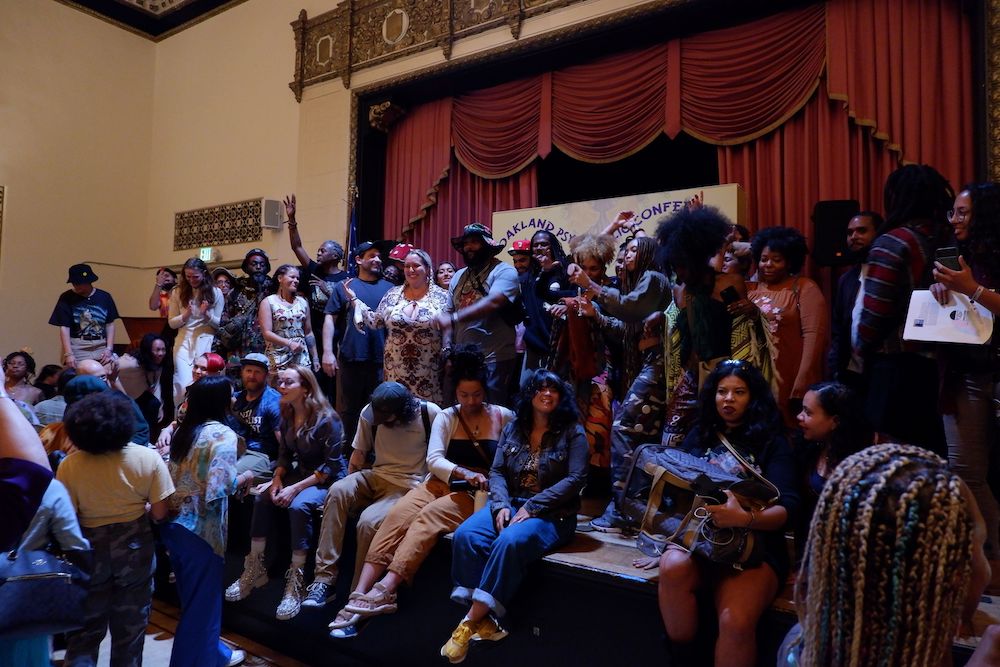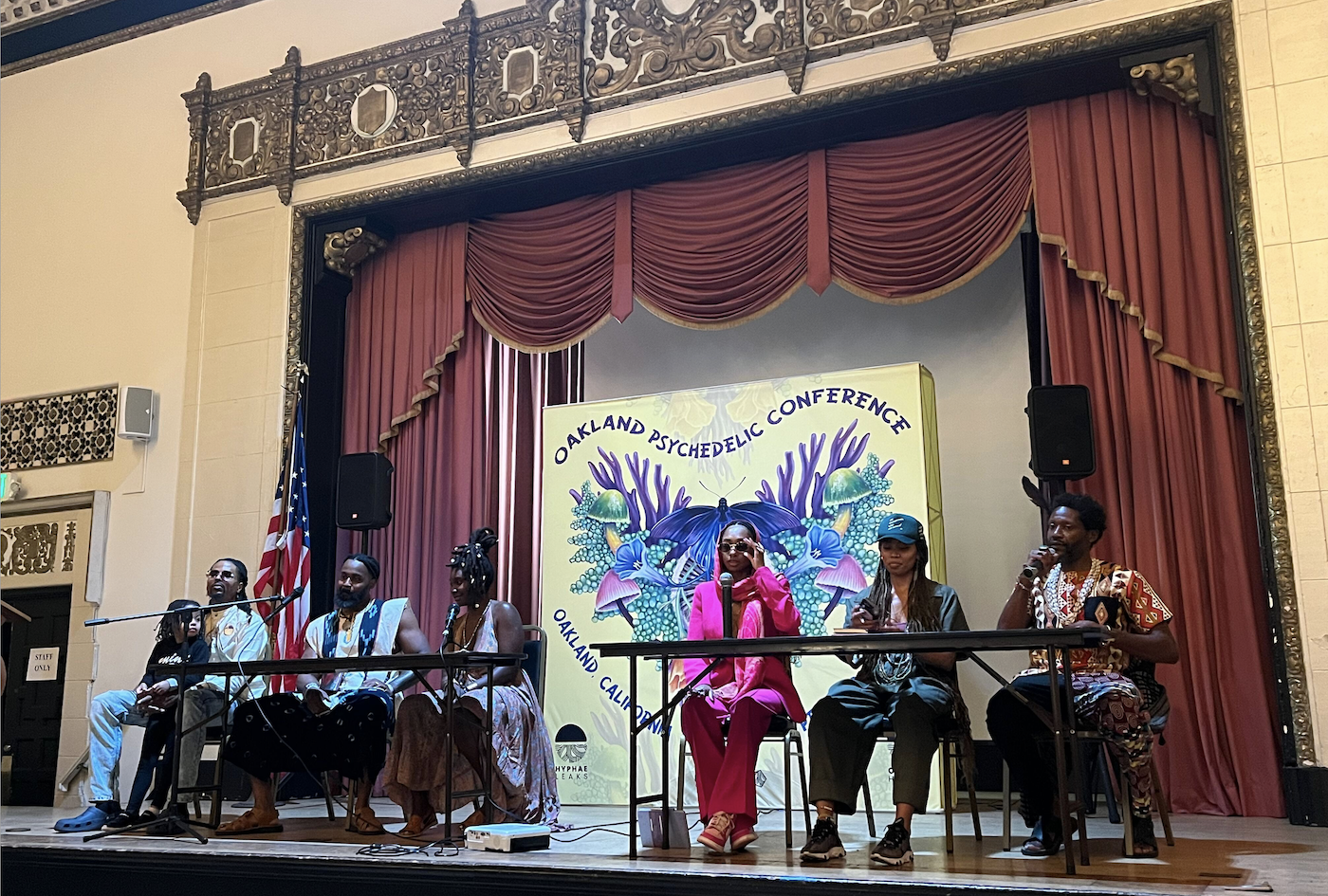“Who here is a drug user?” asked Maurice Byrd, co-director of the Harm Reduction Therapy Center (HRTC) in San Francisco and a private-practice psychedelic therapist.
At some psychedelic conferences, the majority of hands might remain down. Psychedelics aren’t drugs, the common narrative goes, they’re medicine. Here, nearly every hand shot up. This was the harm reduction room at the Oakland Psychedelics Conference, a Black-led event hosted by mycologist and policy advocate Reggie Harris and his psychedelic culture organization, Oakland Hyphae.
In its third year, the September 17-18 conference expanded to include programming from science and policy to mycology and cultivation, sex and health, religion, Indigenous perspectives, and a femme-led space where people walked barefoot and kids served tea.
It enabled Harris, for the first time, to dedicate two full days to harm reduction. The goal was to bring a harm reduction lens to a psychedelic conversation that’s often dominated by exceptionalist attitudes. Many of the speakers had a foot in both worlds.
“It’s lacking the harm reduction ideas of radical inclusion and defiant hospitality.”
Panels centered challenging conversations about where the psychedelic mainstream falls short. “It’s lacking the harm reduction ideas of radical inclusion and defiant hospitality,” Byrd told Filter, adding that while many talk about “meeting people where they’re at,” they don’t do it physically. His HRTC offers mobile services, from harm reduction supplies to roving clinics and a pop-up kitchen, bringing care to the streets.
The harm reduction perspective is holistic, recognizing that truly living means having basic needs met, Yarelix Estrada of New York City Psychedelic Society said in one panel discussion, which means providing health care and housing as well as needles and naloxone.
“What I appreciate about harm reduction is that we all have the shared value or goal of keeping people alive,” she told Filter, while some in the psychedelic space don’t know what their goals are. For the loudest voices, it’s legalization through the medical model—but without a comprehensive view of access, this risks simply recreating systemic inequalities.
“As harm reductionists, we’re doing really hard work … to try to reduce the overdose epidemic [and] help people meet their needs,” Estrada continued. “I don’t see that as part of the psychedelic space. We hear people talking about how these things are going to change the world … [but] what are you doing to assure people are staying alive?”
Communities around substance use tend to fall into camps that rarely communicate, former community mental health worker Ayize Jama-Everett said in a panel: the harm reduction and anti-drug war crews, and psychedelics advocates. That made the conference a needed forum for connection and knowledge-sharing.
In many psychedelic spaces, panelists said, harm reduction conversations stop at calls to test your MDMA and LSD. But in Oakland, discussions called out the broad human impacts of failed drug policies and the need to not just normalize, but legalize all substances.
“If we’re serious about stopping the drug war … we need to [recognize] it’s not fentanyl killing people, it’s the fact that we’re living in prohibition,” Harris told Filter, linking this to the harms of capitalist systems. “It starts with the ‘least desirables’ of society, and ends up consuming us all.”
Whole industries, he said, revolve around keeping people undereducated and underemployed, and seeding misinformation about drugs and addiction. He credited Dr. Carl Hart, a neuroscientist whose work debunks exceptionalism and determinism, with opening his eyes to the need for broad legalization.
Panelists foregrounded similar messages: that most drug use is not problematic, and that use and substance use disorders exist on a continuum, guided by circumstances rather than genetics. Byrd and fellow organizer Leticia Brown, a therapist at Oakland’s Doorway Therapeutics, described growing up under the D.A.R.E. program, thinking they’d overdose on heroin if they smoked weed, or jump out a window if they used LSD.
“We’re taking back this idea and ‘just saying know,’” Byrd said in a panel. “Know what the drugs are and how they work, what you want from the drugs, and your limits.”
“One of the main reasons I use psychedelics is so I can keep doing harm reduction.”
Speakers touted the benefits of psychedelic therapy, while seeking to join it with harm reduction efforts. And since many harm reduction workers suffer burnout and other negative impacts, panelists said they’d like to see more programs aimed at them.
“One of the main reasons I use psychedelics is so I can keep doing harm reduction,” Estrada said. “I go through intense periods of burnout, and if I didn’t have a way to regulate my emotions … I’m not sure I’d be healthy enough to continue.”

Speakers Maurice Byrd, Rosalind McMillan and Yarelix Estrada
Byrd offers psychedelic therapy and integration at sliding-scale rates to expand access. Doorway and Alchemy Community Therapy Center in Oakland—both of which offer ketamine therapy—also have sliding scales. But they have waitlists for discounted services, and even deep discounts leave many without access.
Patients who do find relief are also immediately sent back to the streets, making “recovery” a complex, moving target. The psychedelic mainstream has a narrower view of set and setting than harm reduction spaces, Byrd told Filter, which look at everything that impacts a person.
The harm reduction perspective, however, tends not to include spirituality, he added, and here, it could take a page from the “love and light crowd.” The average psychedelics user also knows a great deal about drugs, Byrd and Jama-Everett said, calling for greater knowledge-sharing.
Brown spoke of offering a “menu of options” for people who want to “change their relationship” with a drug, such as dosage, time of day and other factors. “People get to figure out what works best for them, and I get to support them.”
Everyone emphasized using the word “drugs” to refer to all substances.
Doorway therapist and longtime harm reductionist Rosalind McMillan, who works with queer people of color in Oakland, said she explores with patients, “What is it you’re trying to achieve, and is it working? Is there something we can figure out how to get for you with other tools?”
Those options might include psychedelic therapy, with substances like psilocybin, ibogaine and ketamine being studied as promising treatments for substance use disorder. Yet many mental health studies still exclude people with histories of using certain drugs. And all agreed on the need for approaches that are more personal and less medical.
We’re all drug users, speakers said, channeling Hart, it’s just that some substances are socially sanctioned. Everyone emphasized using the word “drugs” to refer to all substances, and the need for people to “come out of the closet” as users, especially those in high-profile positions.
The term “psychedelics” is often applied unevenly, they said, used to refer to not only drugs like mushrooms and DMT but ketamine, a dissociative anesthetic, and MDMA, an empathogenic amphetamine. Meanwhile, crack/cocaine, heroin, methamphetamine and especially fentanyl are “drugs,” othering the substances and their users.
The Oakland conference’s organizers reflect the diversity of the legacy psychedelic and plant medicine communities. This stands in contrast to mainstream psychedelic conferences in the United States. In June, at the Psychedelic Science conference organized by the Multidisciplinary Association for Psychedelic Studies (MAPS), founder Rick Doblin’s keynote was interrupted by Indigenous protesters over lack of representation.
The face of the mainstream movement is largely white, male and upper-middle-class, panelists said, which is reflected in everything from its goals to the nature of clinical trials. Meanwhile, those most impacted by “other” drugs are people of color and the poor, Byrd said. And those who draw lines between psychedelics and other drugs are recreating the conditions that caused prohibition in the first place.
Estrada asked of psychedelic leaders: “How do you speak about people who use drugs, health care, [and] housing? Is that part of your orientation, … or is it just this fluffy language around how psychedelics alone will somehow bring us to net-zero trauma by 2027?”
“Psychedelics won’t make us not racist or boundary-crossers.”
Mainstream associations and clinics, having failed to recruit diverse practitioners and participants, are now reaching out to leaders like Byrd to legitimize their offerings, he told Filter. And Estrada cited festivals where white “support” staff disproportionately called police on people of color having challenging experiences, and violated consent with female guests.
“Psychedelics won’t make us not racist or boundary-crossers,” Brown said.

Yet the discussions that unfolded over these two days suggested that harm reduction and psychedelia have more in common than it seems—everyone just needs to talk to each other more. Many in the rooms called this emphasis the conference’s biggest success.
Connecting the communities in this way, Jama-Everett said, could help the psychedelic movement build “a coalition, so it’s not just a bunch of white hippies … [but] everybody, from the ground up.”
Byrd called for the better-funded psychedelic therapy facilities to become more holistic, including all substance users. “Every time you turn around someone has opened up a new healing center,” he said. “Why not orient one toward bringing people in?”
“We don’t have time to be fucking around,” Harris told Filter. “I understand the incrementalist approach, but … it’s been more than 40 years since the drug war started. The government has [very easily] been able to rebrand and sell it back to people who are against [it]. … We need to talk about the real shit.”
Correction, October 3: This article has been edited to reflect that Rosalind McMillan works at Doorway Therapeutics, not Alchemy Community Therapy as originally stated.
All photographs by Holly Regan





Show Comments